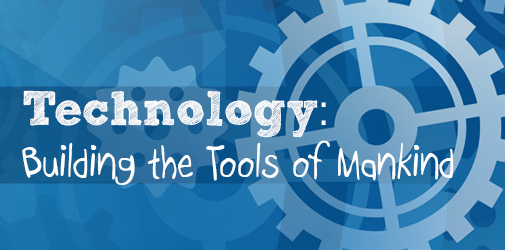 For as long as humans have existed, we have always tried to improve our quality of life. One of our biggest challenges throughout history has been inventing tools to help us in our everyday lives; we wanted to put less effort into getting what we need. The first tools made by man were to help grow crops and hunt animals for food. Eventually, over centuries, we developed massive machines like tractors and plows, to help us grow and gather food over large surfaces of land. As a result, we have saved time and effort in this process, and have therefore made our lives better.
For as long as humans have existed, we have always tried to improve our quality of life. One of our biggest challenges throughout history has been inventing tools to help us in our everyday lives; we wanted to put less effort into getting what we need. The first tools made by man were to help grow crops and hunt animals for food. Eventually, over centuries, we developed massive machines like tractors and plows, to help us grow and gather food over large surfaces of land. As a result, we have saved time and effort in this process, and have therefore made our lives better.
A Look Back in Time
 We didn’t just stop at finding new tools to help us reduce physical labour. Our desire to build machines went beyond the agricultural domain and extended into every other aspect of life. Almost everything we do today involves machines, the so-called “mechanical muscles”. These powerful tools assist us, allowing us to become better and more efficient in a variety of skilled jobs. Technological advances are making our lives more comfortable, safer, and efficient. It is also creating jobs on a daily basis, and new industries are developing more rapidly than ever before. In 1914, the first commercial flight brought the Aerospace industry into existence. Today, this industry employs over 180,000 people in Canada alone. Without technological advances, this would not be possible. More than ever, people are becoming very interested in not only building these mechanical muscles, but also in making mechanical minds. Machines up until this point in history have not been considered to be ‘intelligent’, they were built for a specific task and they executed it. Smarter technology is bringing machines closer to intelligence.
We didn’t just stop at finding new tools to help us reduce physical labour. Our desire to build machines went beyond the agricultural domain and extended into every other aspect of life. Almost everything we do today involves machines, the so-called “mechanical muscles”. These powerful tools assist us, allowing us to become better and more efficient in a variety of skilled jobs. Technological advances are making our lives more comfortable, safer, and efficient. It is also creating jobs on a daily basis, and new industries are developing more rapidly than ever before. In 1914, the first commercial flight brought the Aerospace industry into existence. Today, this industry employs over 180,000 people in Canada alone. Without technological advances, this would not be possible. More than ever, people are becoming very interested in not only building these mechanical muscles, but also in making mechanical minds. Machines up until this point in history have not been considered to be ‘intelligent’, they were built for a specific task and they executed it. Smarter technology is bringing machines closer to intelligence.
Why the Resistance?
 We all know that the existence of small “robots”. They are slow, but if we are to compare their performances with costs, they are very efficient. Just think about the machines and computers that already free up manpower, and they aren’t capable of decision making at all. But today, the first prototype of robotic machines that are capable of making decisions, based on computer programming and databases, have emerged. An eloquent example would be the autonomous car. A car like this is designed to drive by itself, calculating the route, the distance to the car in front, risks involved and many other aspects. Many see them as the future of driving for comfort, safety, and convenience. The same can be said about automatic guidance systems in modern aircraft. The system and software are designed to be overly redundant to ensure safety. This is widely regarded to be more consistent and reliable than a human pilot. These systems have been used for years in the aviation industry, and significantly reduce the workload during critical phases of an aircraft’s flight, therefore ensuring safety and reliability. An autopilot is able to sophistically and independently operate an aircraft, as well as control the altitude, heading, navigation, and more. This type of technology is making its way into other industries, such as manufacturing with laser control.
We all know that the existence of small “robots”. They are slow, but if we are to compare their performances with costs, they are very efficient. Just think about the machines and computers that already free up manpower, and they aren’t capable of decision making at all. But today, the first prototype of robotic machines that are capable of making decisions, based on computer programming and databases, have emerged. An eloquent example would be the autonomous car. A car like this is designed to drive by itself, calculating the route, the distance to the car in front, risks involved and many other aspects. Many see them as the future of driving for comfort, safety, and convenience. The same can be said about automatic guidance systems in modern aircraft. The system and software are designed to be overly redundant to ensure safety. This is widely regarded to be more consistent and reliable than a human pilot. These systems have been used for years in the aviation industry, and significantly reduce the workload during critical phases of an aircraft’s flight, therefore ensuring safety and reliability. An autopilot is able to sophistically and independently operate an aircraft, as well as control the altitude, heading, navigation, and more. This type of technology is making its way into other industries, such as manufacturing with laser control.
Shaping the Jobs of the Future
Technology is allowing humans to shift their attention to new and complex professions every day. Today’s mechanical minds and software bots are essentially creating new jobs that never existed before. The benefits to machines? They are smart, as they can do calculations, analysis, and forecast better and faster. We cannot deny these benefits and the comfort these robots have brought into our lives; they take care of business we don’t like and help us with everyday activities. Yes, machines do create a shift when it comes to the jobs humans are doing – but they allow an evolution into new jobs and new industries, which creates new opportunities. In the end, jobs balance out.
There are some predictions which state that machines will eventually replace human jobs, however we are able to prepare for the future to ensure that instead of replacing jobs, we can reallocate them instead. Due to our increasing dependency on machines and robots, we as a society must grow to work and coexist with our intelligent machines. While some manual labour jobs may get phased out of existence, many more opportunities for engineers, designers, developers, researchers will grow to replace them in order to further evolve our growing technological world. Moral of the story? Robots and technological systems are our friends – they are a key part of the never ending journey of mankind, and as a result, we have saved time and effort in this process, and have therefore made our lives better.
Disclaimer: Any views or opinions presented in this blog post are solely those of the author and do not necessarily represent those of Aversan Inc.
About the Author

Denis Kharlamov is a Software Developer at Aversan. He has been working in an eHealth domain for almost two years, performing software testing and verification. Outside of Aversan, Denis enjoys a variety of different activities such as hiking, swimming, software & web design and development, playing video games and of course sleeping.
Sources
References:
http://www.aiac.ca/resources-and-publications/industry-statistics/
https://www.faa.gov/regulations_policies/handbooks_manuals/aviation/advanced_avionics_handbook/media/aah_ch04.pdf

